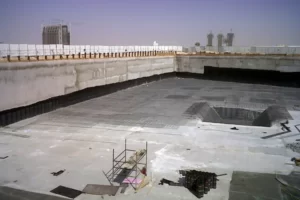
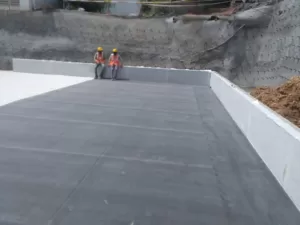
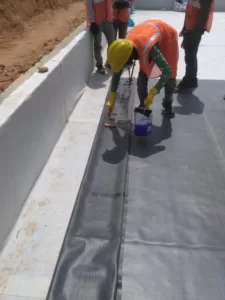
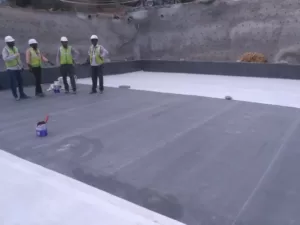
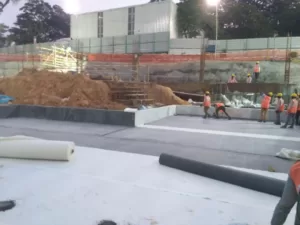
1.EPDM membrane
Description:
EPDM membrane (ethylene propylene diene monomer) is a type of synthetic rubber roofing membrane commonly used for waterproofing flat or low-slope roofs. It is known for its exceptional durability and resistance to weathering, as well as its ability to withstand extreme temperatures and UV radiation.
EPDM membrane is available in a variety of thicknesses and widths, and can be installed using a number of different techniques including ballasted, mechanically fastened, and fully adhered. It is typically black in color, but can also be manufactured in white or other light colors to increase energy efficiency by reflecting sunlight and reducing heat absorption.
EPDM membrane is a popular choice for commercial and residential roofing applications due to its affordability, ease of installation, and long-lasting performance. It is also environmentally friendly and can be recycled at the end of its useful life.
EPDM rubber based prefabricated membrane. It is used for waterproofing &
lining of above & underground concrete structures, because it exhibit high degree of resistance to water, ozone, UV, weathering, abrasion, extreme temperatures, acids, alkalis and oxygenated solvents. EPDM is an elastomeric polymer synthesized from ethylene, propylene and a small amount of diene monomer, compounded with carbon black, processing oils and various cross-linking and stabilizing agents. As a thermoset membrane that recaptures its shape after stretching, EPDM maintains its physical properties for decades..
Uses:
EPDM membranes are commonly used for waterproofing various types of flat and low-slope roofing systems in both commercial and residential applications. Some of the most common applications of EPDM membranes in waterproofing industry includes:
- Roofing: EPDM membranes are ideal for waterproofing flat or low-slope roofs on commercial and residential buildings. They can be used on both new and existing roofs, and are particularly well-suited for large-scale roofing projects due to their cost-effectiveness and ease of installation.
- Pond liners: EPDM membranes are frequently used to line artificial ponds and other water features, as they are resistant to UV radiation and chemical exposure, making them ideal for use in outdoor environments.
- Foundation waterproofing: EPDM membranes can be used to waterproof the foundation of buildings, protecting them from water damage and preventing moisture from seeping into the basement or crawl space.
- Green roofs: EPDM membranes can be used to create waterproof barriers on green roofs, which are covered with vegetation to improve energy efficiency and reduce stormwater runoff.
- Landscaping: EPDM membranes can be used to line planter boxes and other landscaping features, protecting them from water damage and extending their lifespan.
- Canal waterproofing: EPDM membranes are a durable and flexible solution for waterproofing canals, able to withstand harsh environmental conditions and reduce the risk of water loss.
- Podium slab waterproofing: EPDM membranes can be used as an effective and durable solution for waterproofing podium slabs, protecting the underlying structure from water damage and extending the lifespan of the building.
APPLICATION INSTRUCTIONS
The application instructions for EPDM membranes can vary depending on the specific waterproofing application. However, in general, the following steps are typically involved in the installation of EPDM membranes:
Standard EPDM membrane can be either fully adhered to a substrate with compatible bonding adhesive or loose laid and covered with ballast.
Adjoining sheets are spliced together using the seam tape adhesive method. For complete instructions on the installation of EPDM or waterproofing system, please contact us.
- Ballasted installation involves placing a layer of ballast such as gravel, pavers, or soil on top of the EPDM membrane to hold it in place. This method is often used for large-scale roofing projects where a lightweight and cost-effective installation is desired.
- Mechanically fastened installation involves using mechanical fasteners such as screws or nails to secure the EPDM membrane to the substrate. This method is typically used for low-slope roofing systems where wind uplift is a concern.
- Fully adhered installation involves using a special adhesive to bond the EPDM membrane directly to the substrate. This method is often used for vertical surfaces, as well as roofs with complex geometries or irregular shapes.
Overall, the choice of installation technique for EPDM membranes will depend on a variety of factors including the specific waterproofing application, budget, and project requirements.
GEOLIZ WATERPROOFERS PVT. LTD.
Waterproofing Products & Services Guide
For details on other waterproofing products & Services
